Home Page
February 22
February 23
February 24
February 25
Shaw High School and Jesse Williams.
SNCC / CORE Activists
February 26
February 27
February 28
March 1
March 2
March 3
Itinerary
Aknowledgements
Afterwords
|
|
Monday, February 25
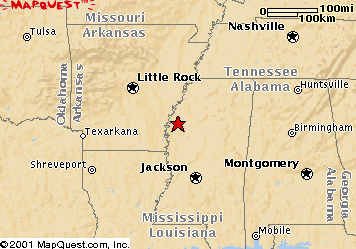
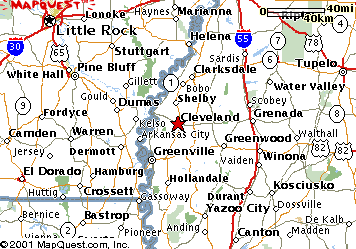
Get
On the Bus 2002: Day 4
-
Shaw High School and meeting with Mrs. Jesse Williams,
the first African-American teacher to integrate Delta
schools.
- Afternoon meetings with L.C. Dorsey, Margaret Block,
and Charles McLaurin, experienced civil rights activists.
Today,
the group visited a number of places in the Mississippi
Delta region, and met people active in the region during
the Civil Rights movement. Settled around the turn of the
century, this region has historically had a large black
population. The area's economy is dominated by
agriculture, and ranks among the poorests parts of the
nation. Below is a journal entry written by trip member
Libby Pozolo.
Journal
Libby Pozolo
Monday 2/25/02
Today was an extremely busy day! Our group had the
opportunity to meet some very interesting people that
were actually a part of the civil rights movement here in
the Mississippi Delta. Luther Brown, the Director of the
Delta Center for Culture and Learning, was a great guide
and took us to some historical sites that were key to the
movement. Margaret Block also accompanied us for today's
events. Margaret was a member of SNCC and very much
involved with voter registration in the 1960s.
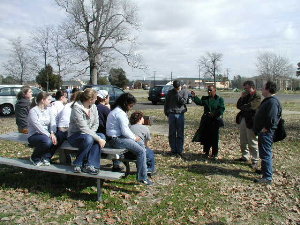
The group talking with Margaret Block in a Amzie
Moore Park in Shaw Mississippi. Amzie Moore heavily
influenced Bob Moses, and other civil rights activists
involved in voter registration in rural Mississippi.
Our first stop was
Shaw High School. I feel that I can speak for the group
when I say that driving through the poverty-stricken city
of Shaw, Mississippi truly opened our eyes to the
unfortunate economic situation in the Delta. The people
live in boarded up "shot-gun shacks" and many
are unemployed. Only eighteen percent of the people here
have cars. The high school itself is also falling apart.
We had the pleasure of meeting with Mrs. Jessie Williams
who played a key role in integrating the Delta schools
and has been at Shaw High School for over 35 years. I
found Mrs. Williams to be especially inspiring. Her
personal stories of how she stood up to segregation and
devoted her life to education were fascinating. Observing
first hand the terrible poverty in this area of the South
was something I will never forget. It really puts things
in perspective and I think made us all realize how much
we really have and should be grateful for.
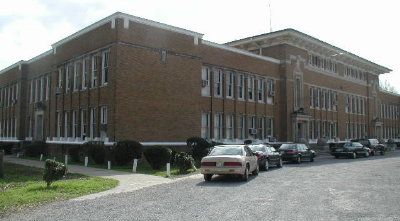
Shaw High School in Shaw, Mississippi. Until 1968,
this school was all white. Today, the school is in danger
of closing because of a declining economy, and shrinking
population. Since 1968, most whites have moved away, and
today those that remain enroll their children in mostly
white Christian schools.
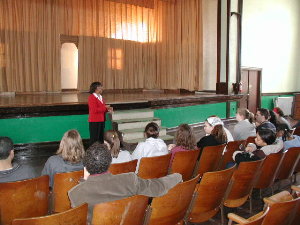
Speaking with Mrs. Williams in the Shaw HS gym. The
podium on the stage reads "Class of 1964", and
the stage curtins date from the 1960s.
After enjoying a
delicious Southern buffet lunch, we headed off to
Mississippi Valley State University to speak with Dr.
L.C. Dorsey. Like Margaret, Dr. Dorsey was a SNCC
activist involved with voter registration. She took us
back to what it was like growing up on a plantation and
shared different experiences she had as a child and young
woman in Mississippi. It was very inspiring to meet such
a distinguished, educated woman who was once a dirt-poor
sharecropper. I would've liked to spend more time at
MVSU, which is a rather small school of about 3,000 and
predominately African-American, and perhaps spoken with
some of the students there, but we had to get back on the
road and head for an actual historic plantation to meet
Mr. Charles McLaurin.

This is why nobody is losing weight on the trip!

On Mississippi Valley State University's campus.
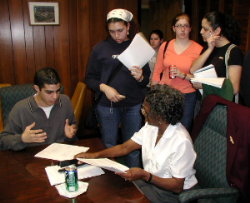
Meeting with L.C. Dorsey. Dr. Dorsey, now a University
Professor, was born of sharecropping parents on a
Mississippi plantation.
At the plantation we listened as Charles described some
of his challenging encounters with recruiting people to
register to vote during the Freedom Summer of 1964. Since
one of our mid-term essays related to this particular
topic, I was especially interested to hear what it was
like for him, as a Mississippi Democratic Freedom Party
delegate, at the national convention in Atlantic City. He
was a very enthusiastic man and had some fascinating
stories relating to the harsh treatment he received from
the KKK and other white supremacist organizations while
in the Delta.

We met with Charles McLauren at Dockery Plantation in
Mississippi. Not only an example of a former
share-cropping plantation, Dockery plantation is known as
the home of the Blues. BB King and other blues musicians
invented much of the music known as the Blues at this
plantation.
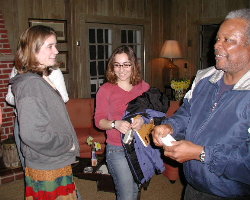
Meeting with Charles McLauren.
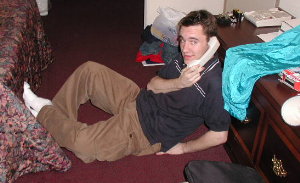
I think Tyler was talking with his Mom.
And that about wrapped up our day. We had a very
interesting group discussion about today's events this
evening. I came away feeling very inspired and anxious to
do something with what we have learned and experienced
when we return back to Ann Arbor. Speaking to people that
were my age when the movement was going on and hearing
the things that they did to make a difference really
changed my way of thinking. Tomorrow we have another busy
day! Good night!
~Libby Pozolo
An
excerpt from Rosa Osorio's journal from today:
We met
Charles McLauren at the "Dockery Plantation" in
Mississippi. He was a part of SNCC and also a major part
in the MFDP. He was an amazing speaker and his story was
inspirational. Telling us that we as individuals could
make a change…"it only takes one person to
stand up!" he said and perceived to prove throughout
the night. I can't comprehend how he could take beatings
and know that at any point he could have been killed! I
know that I could also get to that point and I don't know
how to internalize that possibility…He spoke about
everyone standing behind the leader of the group even if
an individual didn't agree…it's amazing how people
could stick together on issues so potentially
life-changing! I don't know if that could occur today
because so many students and the U.S. in general is so
"self-oriented" and are less concerned with the
well-being of others.
An
excerpt from Jenny Nathan's journal from today:
. . . Tomorrow we will be
meeting Bob Moses, and I am beyond excited. He is
definitely another hero, but he's also another hero who
doesn't see himself as such. None of them do. They just
do what needs to be done, because somebody has to do it.
They don't expect to see change within their own lives,
and they don't expect to personally reap any benefits.
But they have faith enough to believe that it will come,
and are strong enough in their own convictions to keep
fighting the good fight. As Charles McLaurin told us
today, "The movement is in you, or in the individual
who feels hurt enough or indignant enough to get up-to
stand up."
Working in Sunflower
County, Mississippi, McLaurin was repeatedly harassed and
assaulted. As a Mississippi Freedom Democratic Party
delegate to the Democratic National Convention in
Atlantic City that August, he participated firsthand in
the MFDP's failure to be seated. But he never quit, and
he never thought about giving up. Today, when Charles
McLaurin talks about his experiences in the movement, he
is open and honest. You can tell that he looks back on
the time without bitterness or regret. Like Reverend
Shuttlesworth, he has internalized the struggle to the
point where he doesn't need to feel bitter about it. To
invoke Dr. King, these men have been to the mountaintop.
They were there on the frontlines, and they came up
fighting. They're still here, and they'll be damned if
they're not going to enjoy every minute. . . .
Excerpt
from Sarah Leonard's journal for today:
. . . Today
we drove to Shaw High School in Shaw, Mississippi, and
met with Mrs. Jessie Williams, the first Black teacher to
integrate the schools. Shaw was originally an all-White
high school, but it became integrated in the early
Seventies. By the mid-Seventies, Shaw was completely
Black. Today there is only one White student in the
school. I've seen poor schools before, in Grand Rapids,
so the conditions at Shaw didn't faze me the way they
might have other students (except for the hideous green
paint on the walls), but what did surprise me was the
size of the classrooms. We passed by a few rooms, and it
looked like there were fewer than ten students in class.
The photos on the walls of graduating classes showed only
about thirty faces, and I think Mrs. Williams said there
are about three hundred students at Shaw today. It
reminded me of my high school in a way, because Central
used to be the most prestigious school in the city. But
once they forced busing in the Seventies the White
students moved to the suburbs or the parochial schools,
and today Central is considered the poorest high school
in the city, and is majority Black, with a large Latino
population as well. It's crazy the way things can change
in just a few years. . .
|











